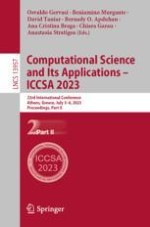The two-volume set LNCS 13956 and 13957 constitutes the refereed proceedings of the 23rd International Conference on Computational Science and Its Applications, ICCSA 2023, held at Lesvos Island, Greece, during July 3–6, 2023.
The 67 full papers and 13 short papers and 6 PHD showcase papers included in this volume were carefully reviewed and selected from a total of 283 submissions. The contributions are grouped in topics which deal with General Track 1: Computational Methods, Algorithms and Scientific Applications; General Track 2: High Performance Computing and Networks; General Track 3: Geometric Modeling, Graphics and Visualization; General Track 4: Advanced and Emerging Applications; General Track 5: Information Systems and Technologies; General Track 6: Urban and Regional Planning; and PHD Showcase Papers.
